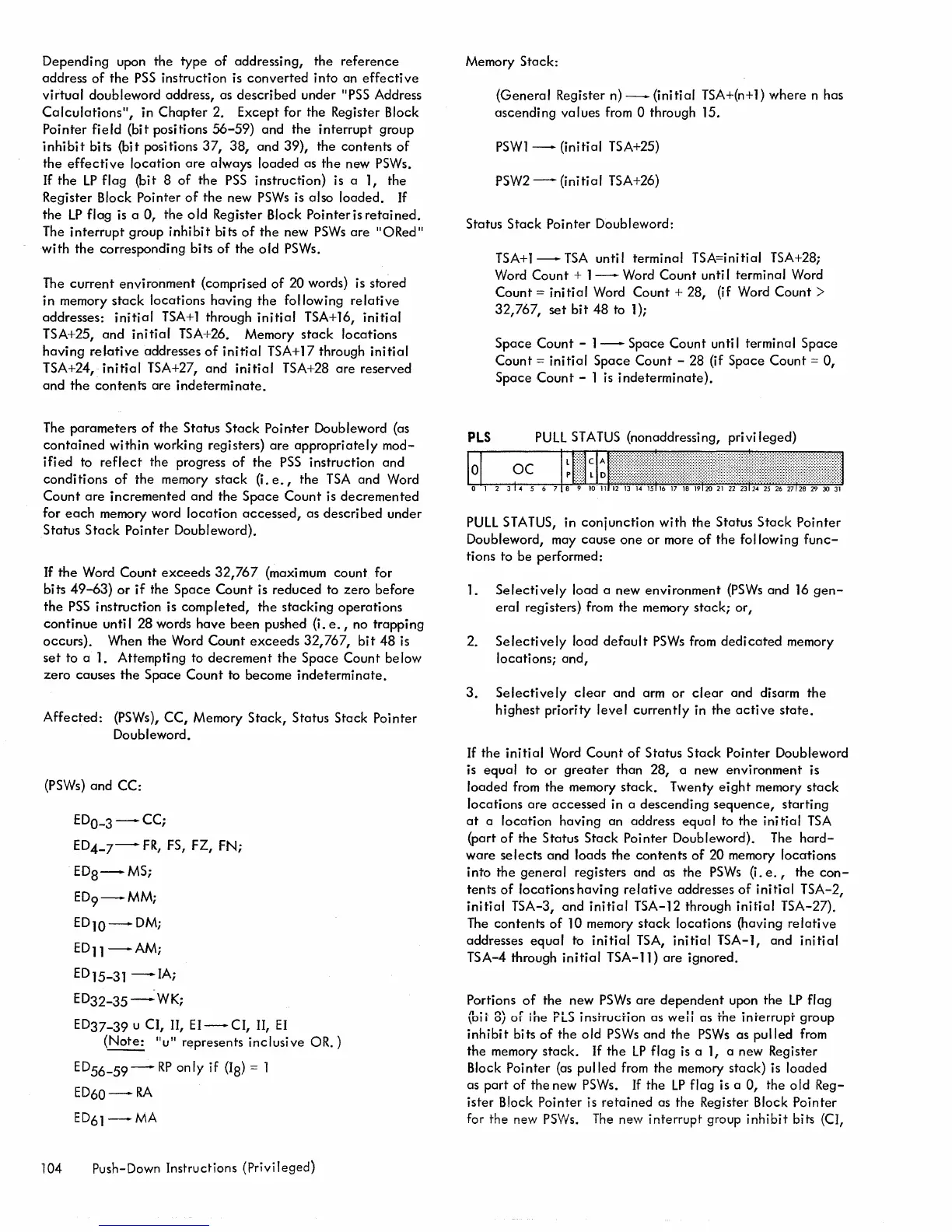Depending upon the type
of
addressing, the
reference
address
of
the
PSS
instruction
is
converted
into an
effective
virtual doubleword address, as
described
under "PSS Address
Calculations",
in
Chapter
2. Except for the Register Block
Pointer
field
(bit positions
56-59)
and
the
interrupt
group
inhibit
bits (bit positions
37,
38,
and 39), the contents
of
the
effective
location
are
always loaded as
the
new
PSWs.
If the
lP
flag (bit 8
of
the
PSS
instruction) is a 1, the
Register
Block Pointer
of
the new
PSWs
is
also loaded. If
the
lP
flag
is
a
0,
the old Register Block
Pointerisretained.
The
interrupt
group
inhibit
bits
of
the
new
PSWs
are
1I0Red
ll
with the corresponding bits
of
the
old
PSWs.
The
current
environment (comprised
of
20 words) is stored
in
memory
stack
locations having
the
following
relative
addresses:
initial
TSA+1
through
initial
TSA+16,
initial
TSA+25,
and
initial
TSA+26. Memory
stack
locations
having
ref-ative addresses
of
initial
TSA+17 through
initial
TSA+24,
initial
TSA+27, and
initial
TSA+28
are
reserved
and
the
contents
are
indeterminate.
The parameters
of
the Status
Stack
Pointer Doubleword (as
contained
within working registers)
are
appropriately
mod-
ified
to
reflect
the progress
of
the
PSS
instruction and
conditions
of
the memory
stack
(i.
e.,
the
TSA
and Word
Count
are
incremented
and the Space
Count
is
decremented
for
each
memory word
location
accessed,
as described under
Status
Stack
Pointer Doubleword).
If
the
Word Count
exceeds
32,767
(maximum count for
bits
49-63)
or
if
the Space
Count
is reduced to zero before
the
PSS
instruction is completed, the
stacking
operations
continue
unti I 28 words
have
been
pushed (i.
e.,
no trapping
occurs). When the Word
Count
exceeds
32,767,
bit
48
is
set
to a
1.
Attempting to
decrement
the
Space
Count below
zero
causes
the
Space
Count
to become
indeterminate.
Affected:
(PSWs), CC, Memory
Stack,
Status Stack Pointer
Doubleword.
(PSWs)
and CC:
EDO_3-CC;
ED4-7-
FR,
FS,
FZ, FN;
ED8-MS;
ED9-MM;
ED10-DMi
ED11-AMi
ED15-31
-IAi
ED32-35-WK;
ED37-39 u CI,
II,
EI
- CI, II,
EI
(Note:
"u
ll
represents inclusive OR. )
ED
56
-
59
-
RP
on
Iy
if
(I8) = 1
E
D
60-
RA
ED61-MA
104 Push-Down Instructions (Privileged)
Memory Stack:
(General
Register n) - (initial TSA+(n+l) where n has
ascending
values from 0 through 15.
PSW1
- (initial TSA+25)
PSW2
- (initial TSA+26)
Status
Stack
Pointer Doubleword:
TSA+1
-
TSA
unti I terminal TSA=initial
TSA+28i
Word Count + 1 - Word
Count
unti I terminal Word
Count
=
initial
Word Count + 28, (if Word
Count>
32,767,
set
bit
48
to 1);
Space Count - 1 - Space Count unti I terminal Space
Count =
initial
Space Count - 28 (if Space Count = 0,
Space
Count
- 1
is
indeterminate).
PLS
PULL
STATUS
(nonaddressing,
privileged)
PULL
STATUS,
in
conjunction
with the Status
Stack
Pointer
Doubleword, may cause
one
or
more
of
the following
func-
tions to be performed:
1.
Selectively
load a new environment
(PSWs
and
16
gen-
eral registers) from
the
memory
stack;
or,
2.
Selectively
load
default
PSWs
from
dedicated
memory
locations;
and,
3.
Selectively
clear
and arm
or
clear
and disarm the
highest priority
level
currently
in
the
active
state.
If the
initial
Word Count
of
Status
Stack
Pointer Doubleword
is
equal to or
greater
than 28, a new environment is
loaded from the memory
stack.
Twenty
eight
memory
stack
locations
are
accessed in a descending
sequence,
starting
at
a location having an address equal to the
initial
TSA
(part
of
the Status
Stack
Pointer Doubleword). The
hard-
ware
selects
and loads the
contents
of
20 memory locations
into the
general
registers and as the
PSWs
(i. e., the
con-
tents
of
locations having
relative
addresses
of
initial
TSA-2,
initial
TSA-3, and
initial
TSA-12 through
initial
TSA-27).
The
contents
of
10
memory
stack
locations (having
relative
addresses
equal
to
initial
TSA,
initial
TSA-l,
and
initial
TSA-4 through
initial
TSA-11)
are
ignored.
Portions
of
the new
PSWs
are
dependent
upon the
LP
flag
II-Ln\
r~t
nlr-
I.-
11.1...
\011
OJ
or
me
fL.)
JnsrruclJon as well as
me
mTerrupT
group
inhibit
bits
of
the old
PSWs
and
the
PSWs
as pulled
from
the memory
stack.
If the
LP
flag
is
a 1, a new Register
Block Pointer
(as
pulled from the memory stack) is loaded
as
part
of
the new
PSWs.
If
the
LP
flag is a 0, the old Reg-
ister Block
Pointer is
retained
as the Register Block Pointer
for the new
PSWs.
The
new interrupt group
inhibit
bits (CI,

